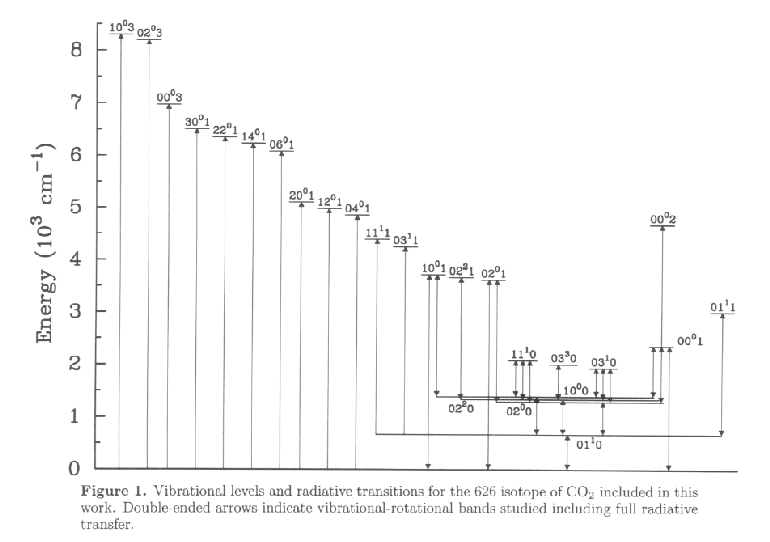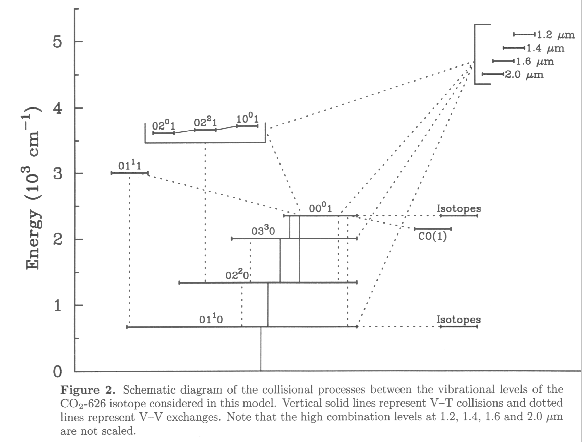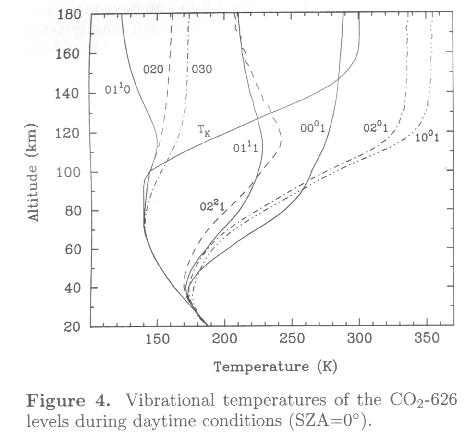|
NON-LTE MODELLING OF IR EMISSIONS IN MARS' ATMOSPHERE
We have been working since the late 80s in the development of a highly complete
non-LTE model for understanding the CO2 atmospheric emissions in Mars, and to
evaluate their impacts on the energy balance of that atmosphere.
This model was specially designed to study potential non-LTE effects in the
remote sounding of the temperature in the martian upper atmosphere by the
instrument PMIRR, which was first flown in 1993 on board the malograted Mars Observer,
and again last year on board the Mars Climate Orbiter mission, which NASA lost (again!) in
September 1999 during the insertion orbit.
Currently we are working on several directions, applying this theoretical model
to a number of radiative studies of the Martian and Venusian atmospheres.
The description of the model and its major results can be found in the
Ph.D. thesis work of M. A. Lopez-Valverde: Emisiones Infrarrojas en la
Atmosfera de Marte", Universidad de Granada, 1990, and in the papers:
A non-local thermodynamica equilibrium radiative transfer model for
infrared emissions in the atmosphere of Mars.
1. Theoretical basis and nighttime populations of vibrational states
Lopez-Valverde, M. A. and M. Lopez-Puertas, J. Geophys. Res., 99, pp.13093-13115, 1994
Abstract [ ASCII text file ]
A non-local thermodynamica equilibrium radiative transfer model for
infrared emissions in the atmosphere of Mars.
2. Daytime populations of vibrational levels
Lopez-Valverde, M. A. and M. Lopez-Puertas, J. Geophys. Res., 99, pp.13117-13132, 1994
Abstract [ ASCII text file ]
Radiative energy balance of CO2 non-LTE infrared emissions in the
Martian atmosphere
Lopez-Puertas, M. and M. A. Lopez-Valverde, ICARUS, 114 113-129, 1995
Abstract [ ASCII text file ]
The complexity of these non-LTE models is double. First, a set of statistical equilibrium
equations for every excited level has to be set up, including all the microscopic processes
afecting the levels, in particular a complex scheme of collisional processes among all the levels.
And second, in a CO2 atmosphere the radiative exchange between layers is important in
many CO2 transitions, and the radiative transfer equation for many bands must be solved accurately,
and simultaneously with the statistical equilibrium equations for every energy level considered.
The following figures are taken from Lopez-Valverde and Lopez-Puertas, JGR, pp.13117-13132, 1994.
 This Figure 1 shows the large number of CO2 vibrational levels necessary to
consider in order to incorporate all the relevant radiative transitions,
particularly during daytime when high energetic levels are pumped by solar
radiation. Subsequent de-excitations populate lower levels, which can
thermalize a fraction of the initial absorption.
This Figure 1 shows the large number of CO2 vibrational levels necessary to
consider in order to incorporate all the relevant radiative transitions,
particularly during daytime when high energetic levels are pumped by solar
radiation. Subsequent de-excitations populate lower levels, which can
thermalize a fraction of the initial absorption.
 In this Figure 2 they are shown the most important collisional processes
included in the model, both vibrational-translational (V-T) and
vibrational-vibrational (V-V) exchanges. The first ones are the responsible
for the cooling or heating of the atmosphere, while the non-thermal
collisions (V-V) are much faster and can lead to departures from LTE for
some levels. See more details in the mentioned papers.
In this Figure 2 they are shown the most important collisional processes
included in the model, both vibrational-translational (V-T) and
vibrational-vibrational (V-V) exchanges. The first ones are the responsible
for the cooling or heating of the atmosphere, while the non-thermal
collisions (V-V) are much faster and can lead to departures from LTE for
some levels. See more details in the mentioned papers.
 And in Figure 4 they are shown the populations of some of the CO2 vibrational
levels. Instead of number density we employ here the concept of vibrational
temperature, which is equivalent but more intuitive to analyize since it can
be compared directly to the kinetic temperature to determine where the levels
are overpopulated (vibrational temperature larger than kinetic temperature) or
underpopulated (vibrational lower than kinetic temperature).
The results correspond to daylight conditions. The asymetric stretching levels
at 4.3 um (0,0,v3) and the combinational levels at 2.7 um (0,v2,v3) are highly
populated by solar absorption in the near-IR, while the bending levels or
15-um levels (0,v2,0) present much smaller populations.
The altitude of LTE departure si also different.
All this must be taken into account for remote sounding of the Martian
atmosphere using these IR emissions.
And in Figure 4 they are shown the populations of some of the CO2 vibrational
levels. Instead of number density we employ here the concept of vibrational
temperature, which is equivalent but more intuitive to analyize since it can
be compared directly to the kinetic temperature to determine where the levels
are overpopulated (vibrational temperature larger than kinetic temperature) or
underpopulated (vibrational lower than kinetic temperature).
The results correspond to daylight conditions. The asymetric stretching levels
at 4.3 um (0,0,v3) and the combinational levels at 2.7 um (0,v2,v3) are highly
populated by solar absorption in the near-IR, while the bending levels or
15-um levels (0,v2,0) present much smaller populations.
The altitude of LTE departure si also different.
All this must be taken into account for remote sounding of the Martian
atmosphere using these IR emissions.
|








